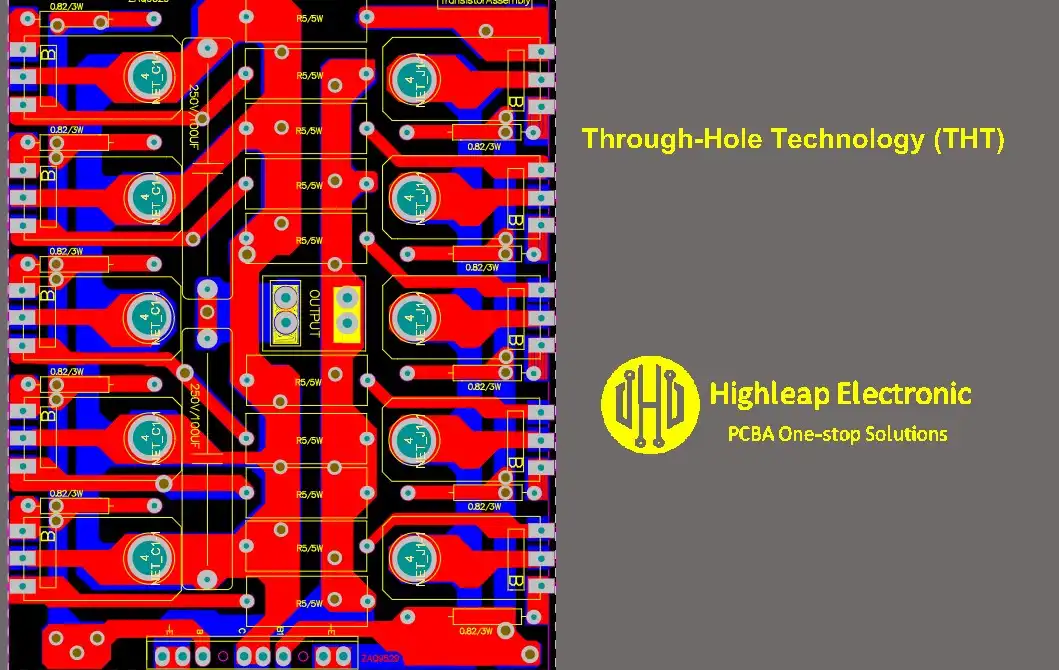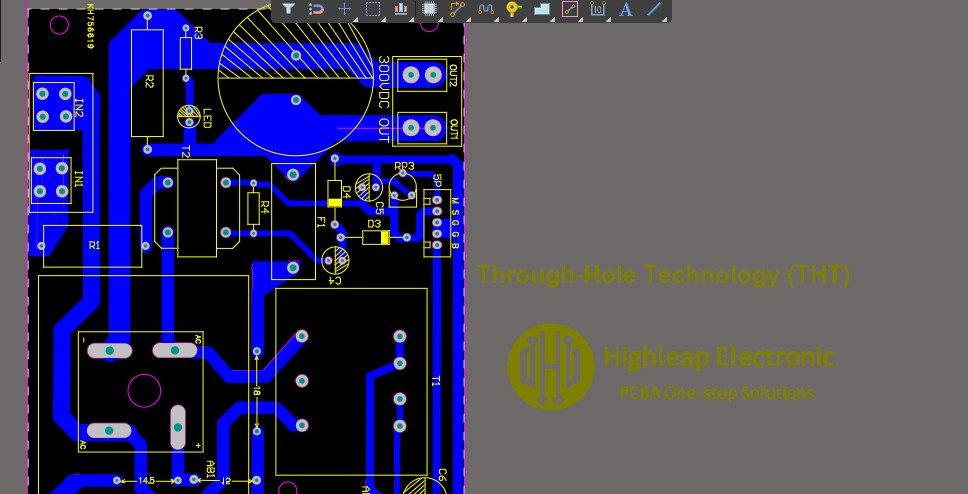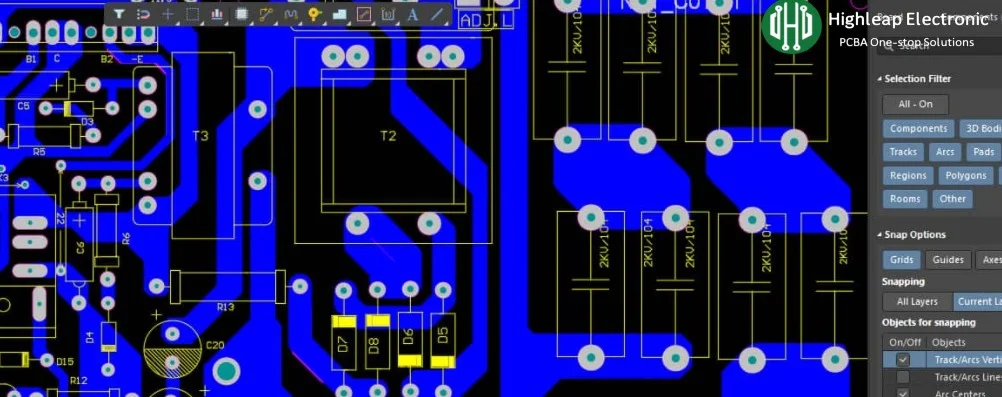Back to blog
Exploring Through-Hole Technology (THT) in PCB Assembly

Through-Hole Technology PCB-THT PCB
PCBs play a pivotal role in various applications, with Through-Hole Technology (THT) being a traditional method for PCB assembly. Despite the emergence of Surface Mount Technology (SMT), THT remains relevant for many reasons. Understanding THT’s components, advantages, and disadvantages provides a deeper insight into PCB mounting technology.
What Is Through-Hole Technology?
Through-Hole Technology (THT) is a method used in the assembly of printed circuit boards (PCBs), where the leads of electronic components are inserted into pre-drilled holes on the PCB. These holes are typically lined with metal (plated through holes) to provide electrical connection and mechanical support for the components. After insertion, the leads are soldered to the PCB to secure the components in place and establish electrical connections. THT has been a traditional method for PCB assembly and is known for its reliability and robustness, particularly in applications requiring high mechanical strength and durability.
Comparison Table Summary between SMT Technology and THT Technology
| Aspect | SMT (Surface Mount Technology) | THT (Through-Hole Technology) |
|---|---|---|
| Components | SOIC, SOT, LCCCP, LCC, QFP, BGA, CSR, Chip resistor/capacitor | DIP, PGA, Lead Resistor/Capacitor |
| Base Board | 1.27mm-grid base board, hole diameter 0.3-0.5mm | 2.54mm-grid base board, hole diameter 0.8-0.9mm |
| Soldering Type | Reflow soldering / Wave Soldering | Reflow soldering / Wave Soldering |
| Area | Small | Big |
| Assembly Tech | Surface mounting | Through hole technology |
| Automation | Automatic Mounter | Automatic Mounter/Manual |
| Advantages | Allows for smaller PCB size and higher component density. | Provides stronger bonds |
| Requires fewer drilled holes, making it more affordable and enabling faster production times. | Ideal for components that will be under stress | |
| SMT components offer more reliable soldering and have proven performance in conditions of vibration and shake. | Good for fast prototyping | |
| Disadvantages | For components that will be under mechanical stress (e.g., connectors) SMT can be unreliable when used as the only method to attach components on a PCB | Drilling holes for through-hole components on a PCB is expensive, time-consuming, limits routing area on multi-layer boards, and requires soldering on both sides, adding to the overall cost and complexity. |
This comparison table provides a concise summary of the key differences between SMT and THT technologies, highlighting their respective advantages and disadvantages in various aspects of PCB assembly.

Through-Hole Technology PCB Assemble – THT PCB Assemble
Through-Hole Assembly
Through-Hole technology encompasses the manufacture of Through-Hole PCBs and the assembly process of installing Through-Hole components into plated through-holes (PTH) and soldering them. This process can be achieved using automation or manual methods.
Automation:
- Import assembly-related files into the equipment to guide the assembly process.
- Based on file instructions, grasp the required components and insert them into the specified holes.
- Establish connections between the component pins and through-holes using wave soldering.
Manual:
- Apply appropriate soldering flux to the component pins.
- Heat the soldering iron for 1-2 minutes to ensure the solder melts immediately.
- Apply solder to the soldering point while simultaneously bringing the soldering iron close to complete the soldering.
- Finally, remove excess pin parts.
The video shows that the PCB automatic vertical plug-in equipment has the advantages of fast plug-in speed, high precision, suitable for various sizes and types of circuit boards, improved production efficiency, reduced labor, and reduced damage and waste.PCB Vertical Plugin
Why use through-hole technology in PCB design?
Using Through-Hole Technology (THT) in PCB design offers several advantages, particularly in scenarios where the electronic device will be subjected to significant stress or harsh conditions:
- Secure Physical Connections: THT provides strong mechanical bonds between components and the PCB, reducing the risk of components becoming dislodged or damaged due to vibrations or mechanical stress.
- Heat Tolerance: Through-hole components typically have larger leads and bodies, allowing for better heat dissipation compared to surface-mount components. This makes THT suitable for applications where components may generate significant heat.
- Power Handling Capabilities: Through-hole components are generally capable of handling higher currents and voltages compared to surface-mount components, making them suitable for high-power applications.
- Durability: The robust construction of through-hole components, along with the secure solder joints they form, makes THT PCBs highly durable and suitable for long-term use in demanding environments.
- Industrial Applications: THT is commonly used in industrial machines and equipment due to its reliability and suitability for high-stress environments. Many industrial PCBs rely heavily on through-hole components for their ruggedness and longevity.
Overall, the use of Through-Hole Technology in PCB design can significantly enhance the durability, reliability, and performance of electronic devices, especially in industrial and high-stress applications.
Types of Through-Hole (THT) Components
Through-hole components can be broadly categorized into axial lead components and radial lead components, each offering unique advantages and suitable for different applications:
- Axial Lead Components: Axial lead components have leads that are attached to the ends of the component and extend along the component’s axis. These leads are inserted into holes on the PCB, and the component is mounted perpendicular to the board’s surface. Axial lead components are often used in applications where space is not a constraint and where components need to be oriented in a specific direction.
- Radial Lead Components: Radial lead components have leads that extend from the same side of the component’s body, forming a radial pattern. These components are mounted parallel to the board’s surface, with the leads inserted into holes on the PCB. Radial lead components are commonly used in applications where space is limited or where components need to be mounted close to the PCB surface.
Both axial and radial lead components can be mounted in two configurations:
- Vertical Mounting: In vertical mounting, the component is mounted perpendicular to the PCB surface. This configuration allows for strong mechanical joints, but the soldering process can be more complex and time-consuming.
- Horizontal Mounting: In horizontal mounting, the component is mounted parallel to the PCB surface. This configuration is often used when space is limited, as it allows for components to be mounted close to the board surface. Horizontal mounting can provide a sturdy mechanical connection and is easier to solder than vertical mounting.
Overall, the choice between axial and radial lead components, as well as between vertical and horizontal mounting, depends on the specific requirements of the application and the space constraints of the PCB design. Each type of component offers unique advantages and can be used to optimize the performance and reliability of the PCB assembly.
Real shot of details of power board vertical material turning into horizontal material slow motion:The precision and craftsmanship of PCB assembly are revealed in the video.
Applications of Through-Hole (THT) Electronic Components
Through-hole technology (THT) components are utilized in various applications due to their robust mechanical joints and reliability. Some common applications include:
High-Voltage Areas: THT components are often used in applications requiring high voltage, such as power supplies and industrial equipment, where a sturdy joint is essential to prevent electrical arcing and ensure safety.
High-Stress Mechanical Devices: THT components are ideal for use in devices subjected to high mechanical stress, such as automotive systems, aerospace applications, and heavy machinery, where components must withstand vibrations and shocks.
High-Power Zones: THT components are suitable for applications requiring high power, such as power converters, amplifiers, and motor drives, where components must handle large currents without overheating or failing.
Devices Operating at High Temperatures: THT components are used in applications where components are exposed to high temperatures, such as in industrial ovens, engine compartments, and aerospace systems, where components must maintain their functionality and reliability under extreme conditions.
Through-Hole Technology(THT) Some key applications include:
-
Power Electronics
-
Military and Aerospace
-
Industrial Controls
-
Medical Devices
-
Consumer Electronics
-
Automotive Electronics
-
Telecommunications
Conclusion
Through-Hole Technology (THT) continues to be a valuable method in PCB assembly, offering secure physical connections, heat tolerance, and power handling capabilities. Its applications span across various industries, showcasing its versatility and reliability in electronic device manufacturing. As technology advances, THT remains a cornerstone in PCB design, ensuring robust and dependable circuitry for a wide range of applications.
PCB & PCBA quick quote
Related Articles

Flexible PCB Cost Optimization Strategy
flexible PCBIn the realm of contemporary electronics, the proliferation of flexible PCBs stands as a testament to the industry's evolution toward miniaturization and functionality. Unlike the more traditional rigid PCBs, which benefit from simpler production...

Enhance Your PCBA Project:Comprehensive Guide to DIP Package
DIP PCB design drawingIn the rapidly evolving world of electronics manufacturing, understanding the impact and evolution of component packaging technologies such as the Dual In-Line Package (DIP) is crucial for any PCBA project. Originally introduced by Fairchild...

High Volume Turnkey PCB Assembly Services
PCB assembly servicesPrinted Circuit Board Assembly (PCBA) is a critical process in electronics manufacturing, where various electronic components are soldered onto a PCB to create a functional electronic device. This comprehensive guide explores the PCB assembly...
